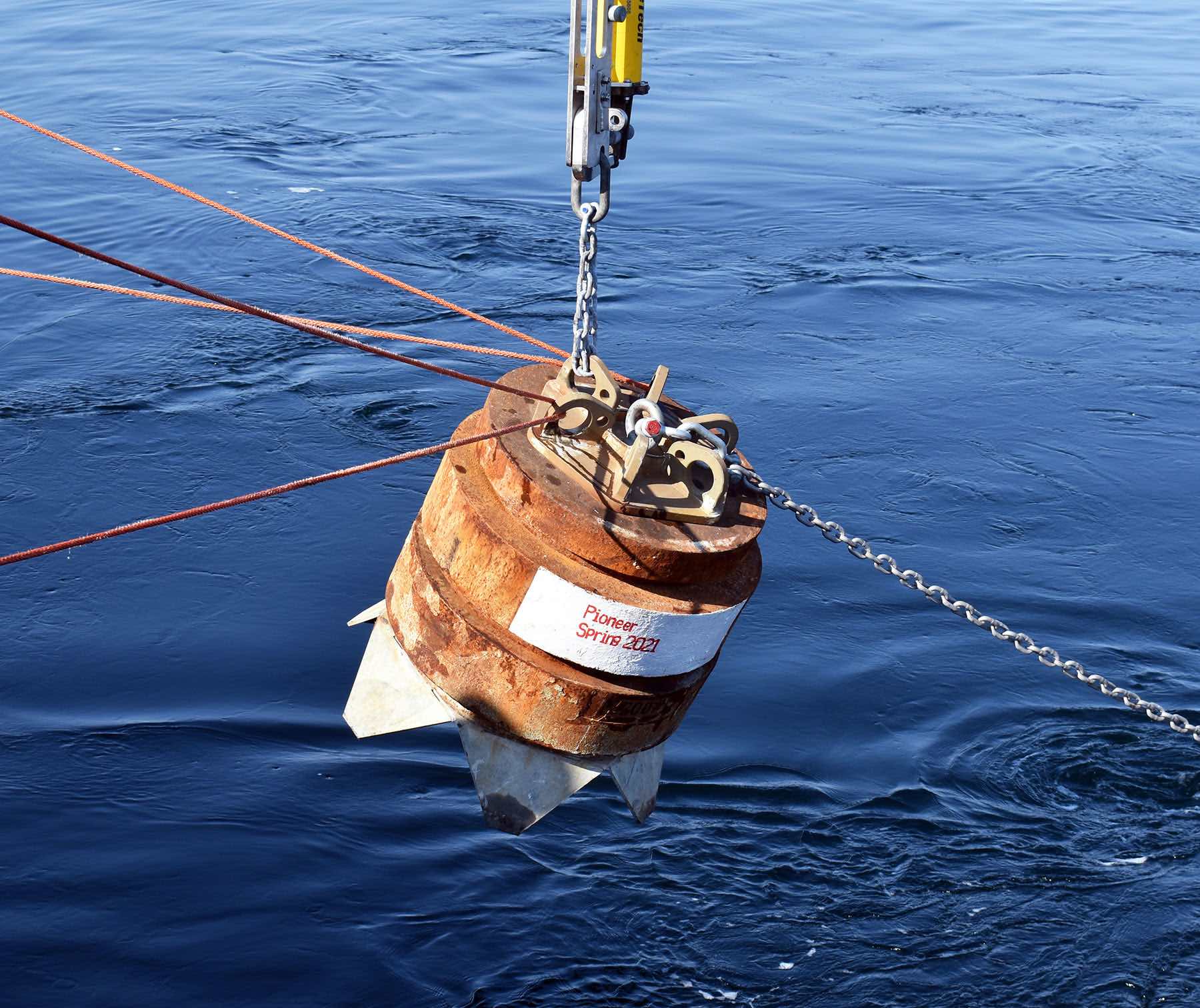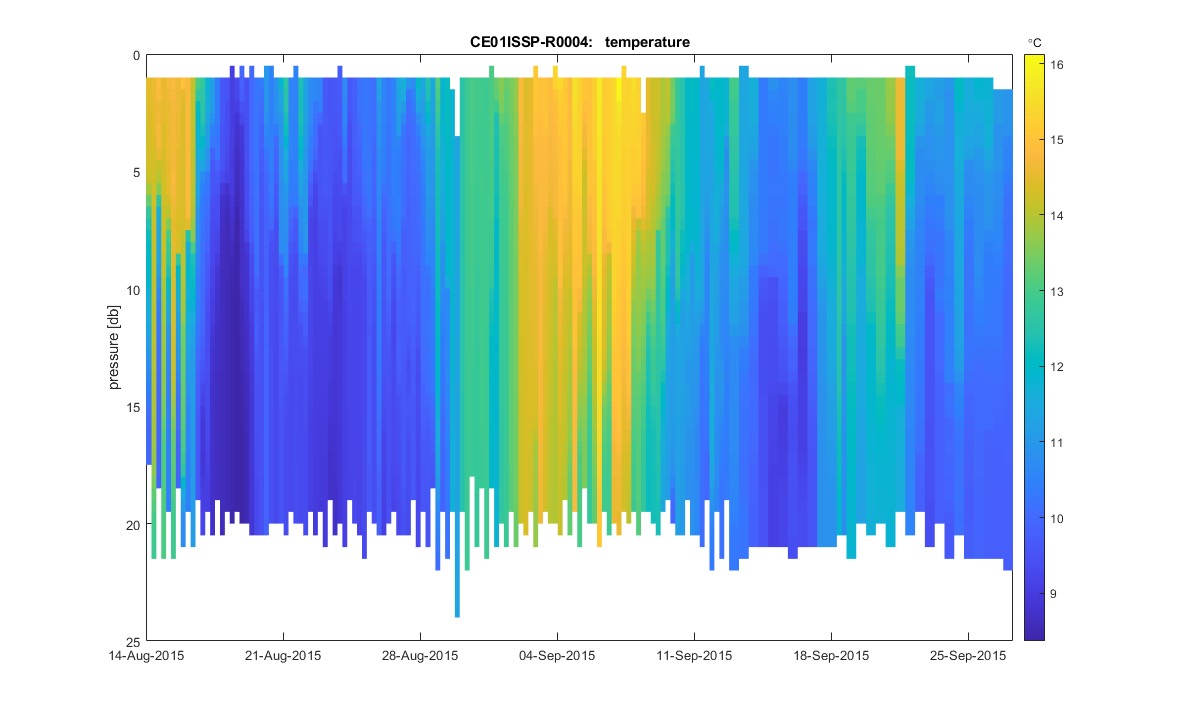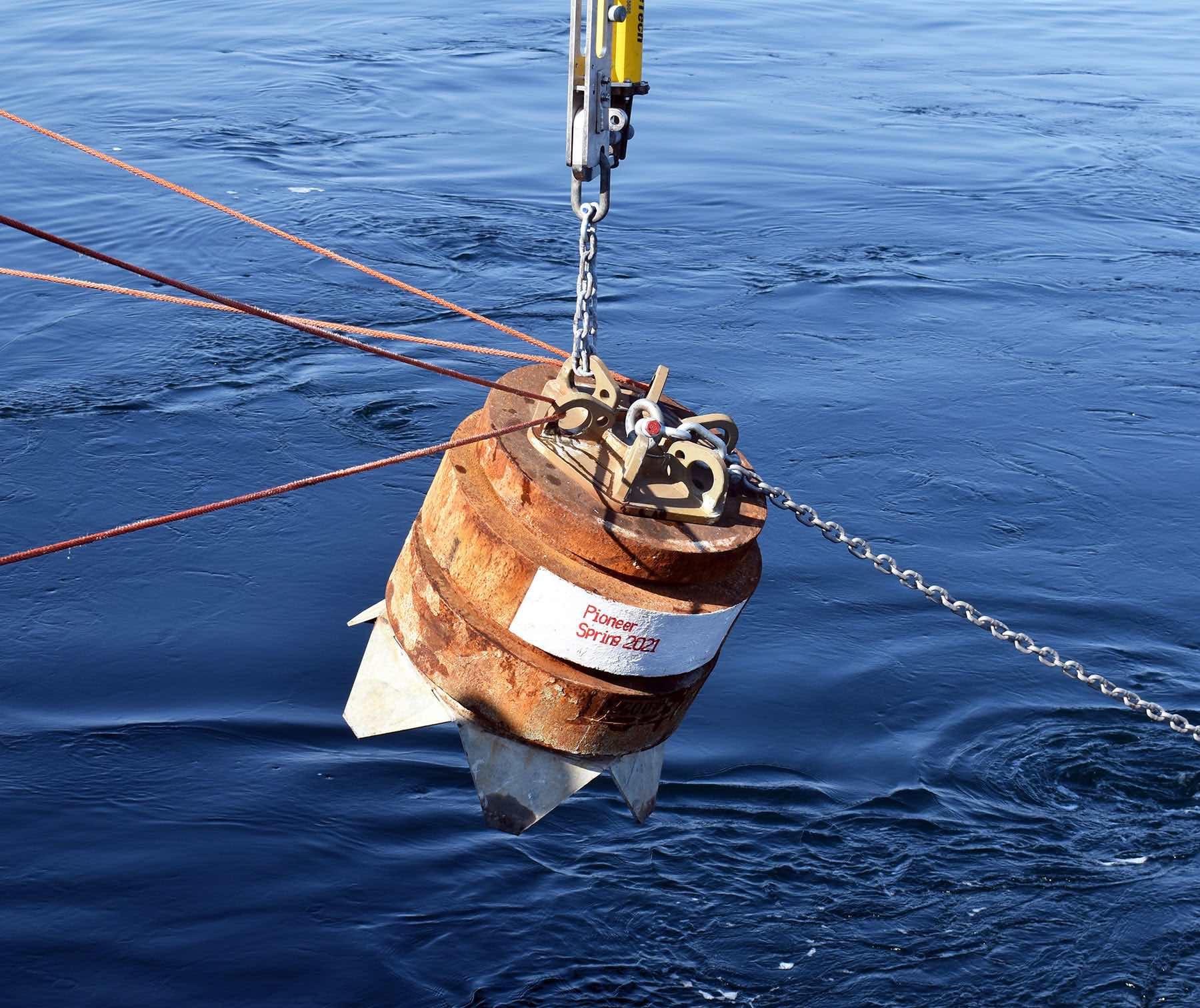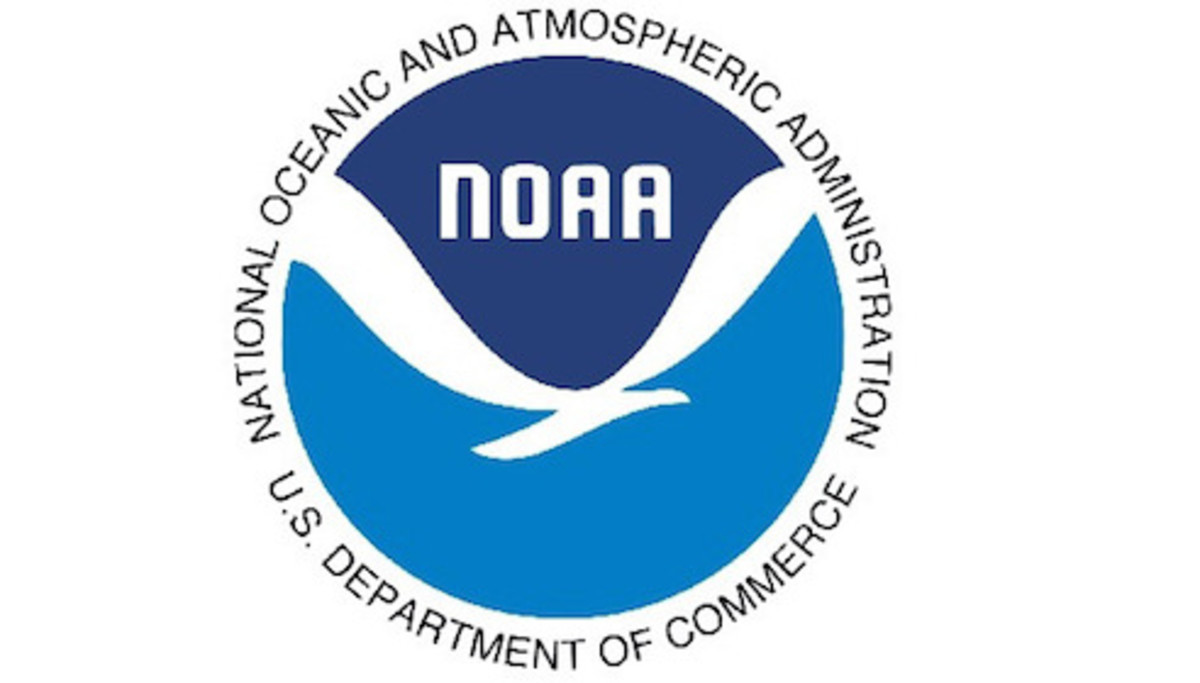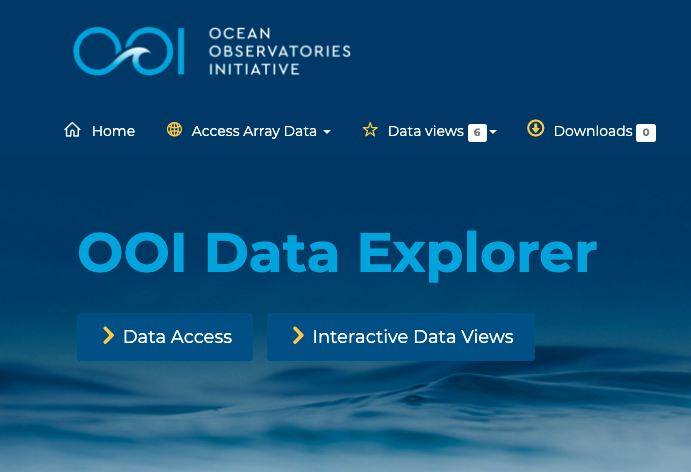News
Eighth Turn of Station Papa Array Set for July
After 20 months in the water, the Global Station Papa Array will be turned (old moorings recovered and new ones deployed) in July for the eighth time. Normally, this array is turned every year, but last year the trip was cancelled due to constraints imposed by the COVID-19 pandemic. In early July, the OOI team will head to Seward, Alaska to begin preparations for this long-due operation.
The OOI team will arrive in Seward and load the R/V Sikuliaq with over 54 tons of equipment. Following one week of equipment mobilization and build, and a precautionary seven-day COVID isolation period, the team will depart for a 16-day cruise in the Northeast Pacific. The team will recover three Station Papa subsurface moorings and deploy three new ones. Along the way, they will also deploy two Open Ocean Gliders, recover one Profiling Glider, and conduct 11 CTD casts, which will help calibrate and validate the instruments on the array. The design of the moorings and gliders, as well as their planned locations, can be found here.
The robust array was designed for a 12-month deployment between turns, but due to COVID this interval had to be extended to 20 months. The extended duration may have affected data quality since bio-fouling on instruments accumulates over time. However, past experience with extended durations has been positive such that the team’s expectations regarding data quality is high.
“Regular maintenance is vital for keeping the arrays working and collecting data, so this cruise is an especially important one,” said Chief Scientist Kris Newhall, who leads the seven members of the Station Papa 8 team.
The moorings have several design updates, including improved controllers and new positioning beacons with GPS and flashers built into the housing. The upgrades will increase the performance of the moorings and simplify recovery operations.
The Global Station Papa Array is an important part of the OOI network, and the data it has collected is helping to shed light on the physical and biological dynamics for this region of the North Pacific.
Read MoreOOI Rolls Out Initial QARTOD Tests

As part of the ongoing the Ocean Observatories Initiative (OOI) effort to improve data quality, OOI is implementing Quality Assurance of Real-Time Oceanographic Data (QARTOD) tests on an instrument-by-instrument basis. Led by the United States Integrated Ocean Observing System (U.S. IOOS), the QARTOD effort draws on the ocean observing community to provide manuals, which outline and identify tests to evaluate data quality by variable and instrument type. Currently, OOI is focused on implementing the Gross Range and Climatology Tests for the variables associated with CTD, pH, and pCO2 sensors. Over the coming months tests will be applied to data collected by pressure sensors, bio-optical sensors, and dissolved oxygen sensors. Ultimately, where and when appropriate, QARTOD tests will be applied to the relevant variables for all OOI sensors.
The Gross Range test aims to identify data that fall outside either the sensor measurement range or is a statistical outlier. OOI identifies failed/bad data with a threshold value based on the calibration range for a given sensor. We also calculate suspicious/interesting data thresholds as the mean ± 3 standard deviations based on the historical OOI data for the variable at a deployed location. As implemented by OOI, the Gross Range test identifies data that either fall outside of the sensor calibration range, and is thus “bad”, or data that are statistical outliers based on the historic OOI data for that location.
The Climatology Test is a variation on the Gross Range Test, modifying the relevant suspicious/interesting data thresholds for each calendar-month by accounting for seasonal cycles. The OOI time series are short (<8 years) relative to the World Meteorological Organization (WMO) recommended 30-year climatology reference period. To help ensure quality, we calculate seasonal cycles for a given variable using harmonic analysis, a method that is less susceptible to spurious values that can arise either from data gaps, measurement errors or from the presence of real, but anomalous, geophysical conditions in the available record. First, we group the data by calendar-month (e.g. January, February, …, December) and calculate the average for each month. Then, we apply the monthly-averaged-data with a two-cycle (annual plus semiannual) harmonic model. Each harmonic is determined using a least-squares fit – a procedure that minimizes the sum of the squares of the differences between the data points and the curve to be fit. This produces a “climatological” fit for each calendar-month.
Next, we calculate the standard deviation for each calendar-month from the grouped observations for the month. The thresholds for suspicious/interesting data are set as the climatological-fit ± 3 standard deviations. Occasionally, data gaps may mean that there are no historical observations for a given calendar-month. In these instances, we linearly interpolate the threshold from the nearest months. For sensors mounted on profiler moorings or vehicles, we first divide the data into subsets using standardized depth bins to account for differences in seasonality and variability at different depths in the water column. The resulting test identifies data that fall outside of typical seasonal variability determined from the historic OOI data for that location.
Read MoreOOI Community Members Guide Pioneer Relocation
From 21-25 June, 37 members of the Ocean Observatories Initiative (OOI) community are participating in the National Science Foundation-sponsored Phase 2 Innovations Lab to identify the best location within the recently designated geographic region of the Mid-Atlantic Bight (MAB) between Cape Hatteras and Norfolk Canyon for the Pioneer Array relocation.
During the week, participants will work to identify the observatory opportunities that can be offered by the new Pioneer Array location. They will explore how the Pioneer Array sensors and platforms can be optimized to achieve science and education goals at a new site, based on environmental, logistical, and infrastructural considerations. The group will also evaluate challenges presented by deployment of Array infrastructure at a new location, and discuss the potential for partnerships and collaborations at a new site.
The MAB region offers opportunities to collect data on a wide variety of cross-disciplinary science topics including cross-shelf exchange, land-sea interactions associated with large estuarine systems, a highly productive ecosystem with major fisheries, and carbon cycle processes. This geographic region also offers opportunities to improve understanding of hurricane development, tracking and prediction, and offshore wind partnerships. The relocation of the Pioneer Array will take place in 2024.
The Ocean Observatories Initiative Facilities Board (OOIFB), in partnership with KnowInnovations, is facilitating the Phase 2 Innovations Lab. “We selected a diverse mix of Lab participants to achieve a broad range of disciplines and professional expertise, career stage (from early to senior), gender, cultural background, and life experience. By involving such a wide range of people in the conversations this week, it is our hope that the innovative quality, outputs, and outcomes of the Lab will be enriched,” said Kendra Daly, chair of the OOIFB. “And, throughout the year, we will continue to work with the community on the exciting optimization process via scientific meetings, seminars, and other means to ensure we receive broad input.”
Read MorePioneer Data Sheds Light on Massive Plankton Blooms
“The big mystery about plankton is what controls its distribution and abundance, and what conditions lead to big plankton blooms,” said Dennis McGillicuddy, Senior Scientist and Department Chair in Applied Ocean Physics and Engineering at the Woods Hole Oceanographic Institution (WHOI).
Two new papers explore this question and provide examples of conditions that lead to massive plankton blooms with vastly different potential impacts on the ecosystem, according to McGillicuddy, co-author of both papers. Both papers also point to importance of using advanced technology—including video plankton recorders, autonomous underwater vehicles, and the Ocean Observatories Initiative’s Coastal Pioneer Array—to find and monitor these blooms.
In one paper, Diatom Hotspots Driven by Western Boundary Current Instability, published in Geophysical Research Letters (GRL), scientists found unexpectedly productive subsurface hotspot blooms of diatom phytoplankton.
In the GRL paper, researchers investigated the dynamics controlling primary productivity in a region of the Mid-Atlantic Bight (MAB), one of the world’s most productive marine ecosystems. In 2019, they observed unexpected diatom hotspots in the slope region of the bight’s euphotic zone, the ocean layer that receives enough light for photosynthesis to occur. Phytoplankton are photosynthetic microorganisms that are the foundation of the aquatic food web.
It was surprising to the researchers that the hotspots occurred in high-salinity water intruding from the Gulf Stream. “While these intrusions of low‐nutrient Gulf Stream water have been thought to potentially diminish biological productivity, we present evidence of an unexpectedly productive subsurface diatom bloom resulting from the direct intrusion of a Gulf Stream meander towards the continental shelf,” the authors note. They hypothesize that the hotspots were not fueled by Gulf Stream surface water, which is typically low in nutrients and chlorophyll, but rather that the hotspots were fueled by nutrients upwelled into the sunlight zone from deeper Gulf Stream water.
With changing stability of the Gulf Stream, intrusions from the Gulf Stream had become more frequent in recent decades, according to the researchers. “These results suggest that changing large‐scale circulation has consequences for regional productivity that are not detectable by satellites by virtue of their occurrence well below the surface,” the authors note.
“In this particular case, changing climate has led to an increase in productivity in this particular region, by virtue of a subtle and somewhat unexpected interaction between the physics and biology of the ocean. That same dynamic may not necessarily hold elsewhere in the ocean, and it’s quite likely that other areas of the ocean will become less productive over time. That’s of great concern,” said McGillicuddy. “There are going to be regional differences in the way the ocean responds to climate change. And society needs to be able to intelligently manage from a regional perspective, not just on a global perspective.”
The research finding demonstrated “a cool, counterintuitive biological impact of this changing large scale circulation,” said the GRL paper’s lead author, Hilde Oliver, a postdoctoral scholar in Applied Ocean Physics and Engineering at WHOI. She recalled watching the instrument data come in. With typical summertime values of about 1-1.5 micrograms of chlorophyll per liter of seawater, researchers recorded “unheard of concentrations for chlorophyll in this region in summer,” as high as 12 or 13 micrograms per liter, Oliver said.
Oliver, whose Ph.D. focused on modeling, said the cruise helped her to look at phytoplankton blooms from more than a theoretical sense. “To go out into the ocean and see how the physics of the ocean can manifest these blooms in the real world was eye opening to me,” she said.
Another paper published in the Journal of Geophysical Research: Oceans (JGR: Oceans), A Regional, Early Spring Bloom of Phaeocystis pouchetii on the New England Continental Shelf, also was eye opening. Researchers investigating the biological dynamics of the New England continental shelf in 2018 discovered a huge bloom of the haptophyte phytoplankton Phaeocystis pouchetii.
However, unlike the diatom hotspots described in the GRL paper, Phaeocystis is “unpalatable to a lot of different organisms and disrupts the entire food web,” said Walker Smith, retired professor at the Virginia Institute of Marine Science William and Mary, who is the lead author on the JGR: Oceans paper. The phytoplankton form gelatinous colonies that are millimeters in diameter.
When Phaeocystis blooms, it utilizes nutrients just like any other form of phytoplankton would. However, unlike the diatoms noted in the GRL paper, Phaeocystis converts biomass into something that doesn’t tend to get passed up the rest of the food chain, said McGillicuddy.
“Understanding the physical-biological interactions in the coastal system provides a basis for predicting these blooms of potentially harmful algae and may lead to a better prediction of their impacts on coastal systems,” the authors stated.
Massive blooms of the colonial stage of this and similar species have been reported in many systems in different parts of the world, which Smith has studied. These types of blooms probably occur about every three years in the New England continental shelf and probably have a fairly strong impact on New England waters, food webs, and fisheries, said Smith. Coastal managers need to know about these blooms because they can have economic impacts on aquaculture in coastal areas, he said.
“Despite the fact that the Mid-Atlantic Bight has been well-studied and extensively sampled, there are things that are going on that we still don’t really appreciate,” said Smith. “One example are these Phaeocystis blooms that are deep in the water and that you are never going to see unless you are there because satellites can’t show them. So, the more we look, the more we find out.”
Both of these studies were carried out as part of the National Science Foundation-funded Shelfbreak Productivity Interdisciplinary Research Operation at the Pioneer Array involving partners at WHOI, University of Massachusetts Dartmouth, Massachusetts Division of Marine Fisheries, Virginia Institute of Marine Science, Wellesley College, and Old Dominion University. Additional support has been provided by the Dalio Explorer Fund.
For more information, see the video “Life at the Edge: Plankton Growth at the Shelf Break Front,” produced by ScienceMedia.nl for WHOI.
Read MoreTackling Sea Surface Sampling Issues
The sea surface is the hardest place to work, according to Jonathan Fram, Project Manager of the Coastal Endurance Array. That’s because at the surface, waves are constantly sloshing around. At any time, a large wave can tug on mooring winch lines, creating sudden tension, which can wear down cables and even cause them to break.
Scuba divers know that surface waters are rough, but below a certain depth—about one wave orbital below the surface—the waters calm significantly. Unfortunately, a lot of great science takes place at the surface, so it’s important for sampling instruments like the Coastal Surface Piercing Profiler (CSPP) to be able to withstand the waves at and near the surface. Fortunately, OOI engineers have found ways to meet the many challenges of working in this rough environment.
“The Coastal Endurance Array Team has made changes to the CSPP to make it more robust, so that we can get the kind of continuous time series that are so valuable to scientists,” said Fram.
A CSPP spends most of its time near the sea floor, but either two or four times a day, the profiler winches itself up to the surface, taking samples as it ascends. Once it reaches the surface, the profiler sends its data back to shore and then quickly returns to the safety of the seafloor. Profilers are important ocean observatory tools because they can help capture what is happening at certain depths where stationary instruments aren’t present. “We’ve had times where you get a persistent chlorophyll bloom at a certain depth where there is zero mooring data,” explained Fram. “So the CSPP sampling is needed to make sense of what’s happening. It’s impossible to have all the instruments at all depths. The CSPP fills in this gap.”
Last year, the Coastal Endurance Array team reviewed their activities looking for ways to reduce lost time at sea. One thing they discovered was that the anchor systems of the CSPPs were unreliable. To deal with this problem, the team created a new kind of anchor. The old profiler anchors had a chain between the profiler and anchor that helped dampen the waves so that the device was not tugged on when resting in between profiles. The chain, however, made it difficult to deploy the anchor in an upright position. Anchors need to be deployed upright so their recovery floats can be acoustically released. The team redesigned the anchors so they now behave like a weeble wobble toy that is weighted so it always rights itself. This new design makes it hard to deploy an anchor upside down, making the anchors more reliable.
The team also made updates to the modems that send data to shore. When the CSPP is at the surface, the winch must stay on because it keeps the antenna vertical. This time-on takes up about a quarter of the battery power. To reduce the power demand, the team switched out some of the iridium modems for cellular modems, which has allowed the CSPPs to send data more quickly. A faster modem means that the profiler spends less time at the surface, not only saving power, but reducing the risk of being damaged by a large wave. The team is currently working on upgrading to faster cellular modems that can connect further from shore.
“At the same time we are making these updates on the Oregon Shelf Mooring, we’re also implementing them on the Washington Shelf Mooring,” said Fram. “So an improvement on one platform is also leading to an improvement on another platform.”
A third innovation involves improvements to the batteries.
“When waves tug on the winch, it goes from being a power sink to a power source. That sometimes creates power spikes that can fry the connectors. So we’ve rewired the batteries to make them more robust,” explained Fram. The rewiring is expected to reduce the number of power failures and keep the CSPPs running continuously. “Since April when we first started using the rewiring scheme, we’ve had four profilers in the water with no problems for six weeks,” said Fram.
The team also is in the process of replacing batteries that power the profiler with their own design of rechargeable batteries. While OOI engineers prefer to use commercially available parts for easier repair and replacement, when parts on the market don’t fit their needs, they design their own. The new batteries will be more reliable than those they are replacing. The newly designed batteries will also be deployed on the wire-following profilers on the Coastal Pioneer Array.
“My focus is on making all of the Coastal Endurance instrumentation work,” said Fram. “When we’re able to get a full three months’ deployment through the winter, through super rough seas, that makes my day. Making improvements is what I look forward to the most.”
Read MoreApplications for the Pioneer Array Innovations Lab 2 due May 31st
Applications to apply for the Pioneer Array Innovations Lab 2 are due on May 31st. The Lab will be held each day during the week of June 21-25 (about 5-6 hours each day). During this Lab, participants will work to identify the observatory opportunities that can be offered by the Pioneer Array at its new location at the Mid-Atlantic Bight. Details are provided below.
The application form for the Pioneer Array Innovations Lab 2 is available here.
To learn more or to apply, please visit here.
Read More
Innovative Instruments on the RCA
The Regional Cabled Array (RCA) provides power and bandwidth to a set of core OOI pressure sensor and tiltmeter instruments, developed by Dr. W. Chadwick, which measure subsidence or uplift of the seafloor, an important indicator of activity at Axial Seamount. But these instruments undergo slow instrumental drift, which can be misinterpreted as seafloor height changes. To increase measurement accuracy, three novel instruments have been added to the RCA – the self-calibrating pressure recorder, flipping tilt meter, and A-0-A pressure sensor – to account and correct for instrument drift.
Researchers are field testing these new drift-and pressure-measuring instruments and comparing results with the conventional instruments onsite, with the intent of identifying which might be the most reliable over the long-term and under specific conditions. The pressure and tilt data being collected and served by these instruments are being incorporated into models that are increasing understanding of volcanic activity at isolated and hard-to-measure sites such as Axial Seamount. The instrument placements and ongoing research is supported by the National Science Foundation.
Flipping Tilt Meter and A-0-A
Dr. William Wilcock, of the University of Washington, oversees the flipping (or rotating) tilt meter and the A-0-A (A zero A) sensor deployed on the RCA for three years at Axial: it will be recovered this summer. The A-0-A is currently deployed within Axial’s Caldera at the Central Caldera site.
Tilt meters are widely used on volcanoes because when volcanoes inflate the tilt of the ground changes. Because conventional tilt meters drift a lot, they are only useful in environments where there are big signals, or where changes happen quite quickly. The flipping tilt meter corrects for this drift and allows it to be used in areas with smaller, more subtle changes.
Wilcock explains the corrective principle, “I have an old-fashioned kitchen scale with a rotating needle. Every time I put the tray on top of the scale, I have to zero it out by turning a dial. All three instruments are based on resonant quartz crystal sensors which drift, so our calibrations are similar to the principle in a kitchen scale with a dial adjustment. “
A flipping tilt meter is a three-component accelerometer, which measures the acceleration of the Earth, in the vertical and in two horizontal directions. In the vertical, it measures the acceleration of gravity, 9.8 meters per second squared. In the horizontal, there’s no acceleration of gravity, so it measures nothing. But if the instrument tilts, a small component of gravity pulls the horizontals in the downward direction because the instruments are no longer completely level.
“Every month we rotate one of the horizontal channels into the vertical to measure the acceleration of gravity, which doesn’t change. So we compare the rate of acceleration of gravity from the prior measurement and calculate how much the instrument had drifted and correct for that drift,” added Wilcock. Wilcock and his team have tested the flipping tilt meter on land at Piñon Flat in California and now on the seafloor at Axial Seamount.
At Axial, the flipping tilt meter has been proven to measure tilt within about one part in 106—a very small tilt signal. Wilcock hosts data collected by the flipping tilt meter through IRIS, the Incorporated Research Institutions for Seismology. Wilcock and his team are currently writing a paper where the calibration data from the instrument will be shared.
Wilcock hopes the next test site for the flipping tiltmeter is placement in a borehole, where it can be secured so as to not experience drift nor temperature changes. Because the flipping tiltmeter doesn’t need recalibration, it holds promise for being a simple sort of “plug and play type” of tiltmeter.
[caption id="attachment_20232" align="alignright" width="400"]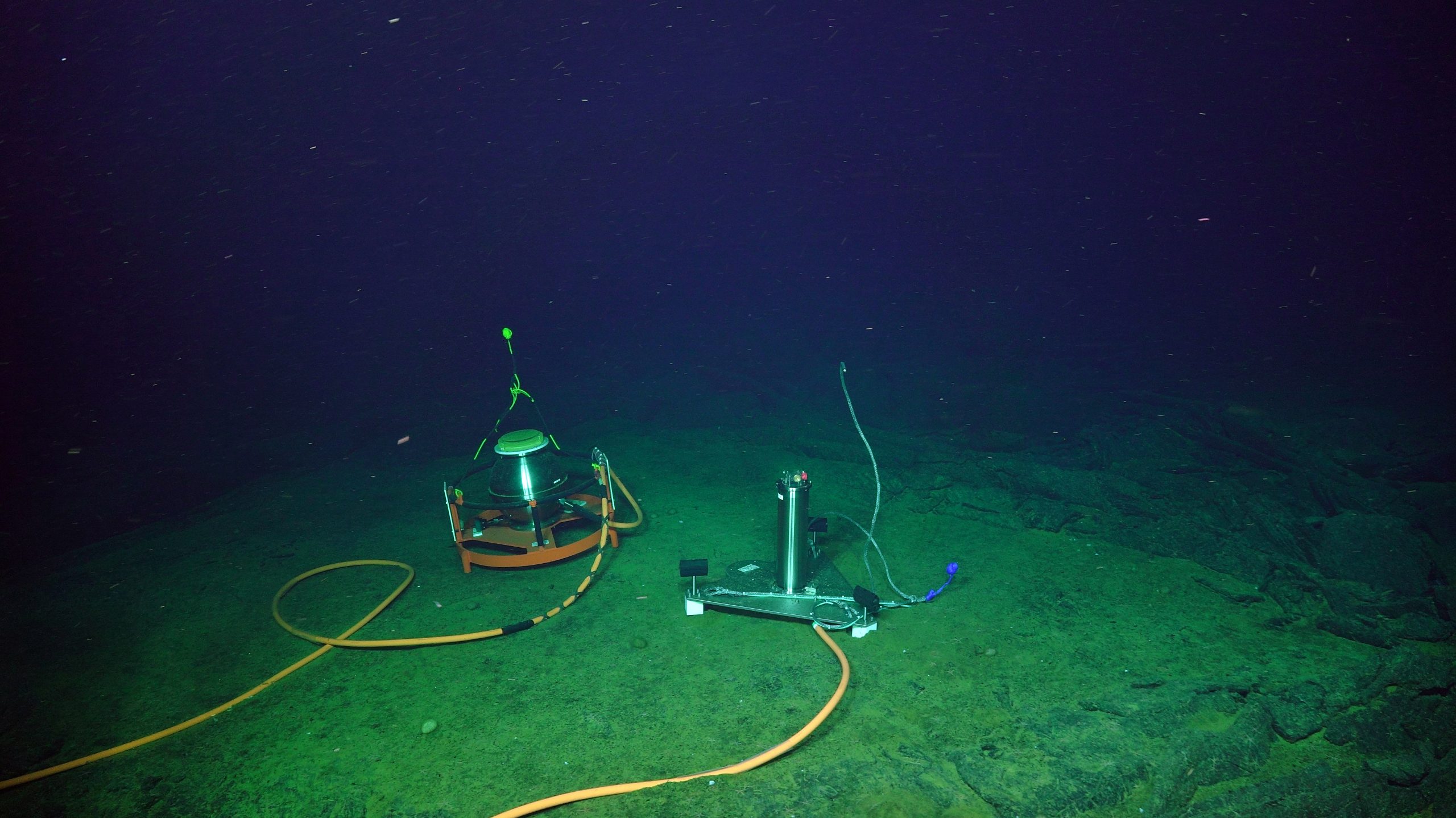 The Self-Calibrating Pressure Recorder (left) sits adjacent to the A-O-A instrument allowing cross comparison of data focused on seafloor deformation. Credit: UW/NSF-OOI/WHOI; V19.[/caption]
The Self-Calibrating Pressure Recorder (left) sits adjacent to the A-O-A instrument allowing cross comparison of data focused on seafloor deformation. Credit: UW/NSF-OOI/WHOI; V19.[/caption]
Wilcock also has an A-0-A (Ambient – zero for atmospheric pressure- Ambient) instrument co-located with the Self-calibrating Pressure Recorder at Central Caldera. The A-0-A instrument compares ocean pressure to atmospheric pressure, calculated by a barometer within the instrument to determine drift.
The A-0-A is equipped with two redundant pressure sensors and a valve that switches from measuring the pressure at the seafloor to measuring the pressure internal to the instrument.
When the valve switches to the internal pressure of the instrument, the drift of the two pressure sensors can be measured by comparing their reading to a barometer inside the instrument. If the calibration is working, then the two calibrated readings of the two sensors should give the same reading when the valve switches back and they measure the pressure at seafloor. Early results show that they agree within a few millimeters per year in 1500 meters of water.
University of Washington graduate student Erik Fredrickson is using data from the Flipping Tilt and A-0-A meters to help refine models of the inflation occurring at Axial Seamount. “With pressure data, you can see the pressure increasing and decreasing in minutes. Pressure measurements work opposite of what you might expect for we are basically measuring the weight of the water. So as a volcano inflates, it lowers pressure on a seafloor instrument, and when it erupts, we get a higher-pressure signal. It’s really helpful to have accurate pressure measurements so we can understand how the volcano is behaving.”
Self-calibrating Pressure Recorder
Drs. Glen Sasagawa and Mark Zumberge of the Institute of Geophysics and Planetary Physics at Scripps Institution of Oceanography, University of California, San Diego conceived of and built a self-calibrating pressure recorder (SCPR) in 2013. They initially tested their battery-operated prototype off the coast of California. All data were stored on the instrument, which had to be retrieved by boat and uplinked data back to shore.
The SCPR, installed at Axial Seamount in 2018, was a much more sophisticated version consisting of many mechanical elements, including a deadweight tester, an instrument whose history dates back to the 19th century. The deadweight tester consists of a piston that fits inside a closely spaced cylinder, over which a mass is placed. Oil and hydraulic fluid are pumped in until the tester floats up in the middle of the cylinder, causing the piston to rise up. (see diagram below). When that occurs, the weight of the piston (mass x gravity) is balanced by the pressure acting on the surface area of the piston on the bottom. A mathematical formula is applied to calculate pressure (mass x gravity divided by the area).
[caption id="attachment_21228" align="alignleft" width="375"]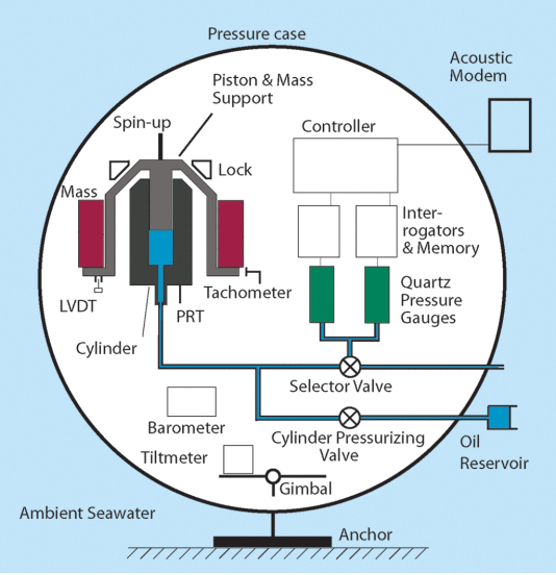 The key components of the SCPR. A 41.6-cm diameter sphere contains two recording pressure gauges which record ambient seawater pressure. Once every ten days for a period of 20 min the two gauges are hydraulically connected to a piston gauge that provides a reference pressure used to determine their drift rates.[/caption]
The key components of the SCPR. A 41.6-cm diameter sphere contains two recording pressure gauges which record ambient seawater pressure. Once every ten days for a period of 20 min the two gauges are hydraulically connected to a piston gauge that provides a reference pressure used to determine their drift rates.[/caption]
One key change since the SCPR prototype is that it is no longer battery-powered. “RCA provided us with a slot on the cable and took care of getting the instrument placed and plugged into the network, and then getting the data onshore to Seattle,” explained Sasagawa. “From an investigator’s perspective, all I have to do to access our data is log onto an FTP site, grab some data, and I’m good to go.”
Every three months or so, Sasagawa logs onto a computer terminal in his office to gain access to the control panel of the SCPR calibrate and operate the SCPR. “I have direct communication with an instrument that is some 1500 meters under the sea, hundreds of miles off the Oregon coast. It’s definitely very cool and an amazing capability,” he added.
The goal is to keep this SCPR onsite at Axial for five-years, during which time data are consistently transmitted and available for researchers here. Sasagawa hopes to next test the efficacy of the SCPR at the Cascadia subduction zone, which runs from Vancouver Island in Canada to northern California, with smaller signals than at Axial.
“I would just add that we can’t overemphasize the importance of having power and communications on the seafloor. With the cable right there, we have the really critical things that we take for granted in our daily lives… Just plugging something into the wall socket, and turning on Wi-Fi. And certainly in the oceans, we just cannot take that for granted. This is key infrastructure. And having data come back in real or near real time is critical,” concluded Sasagawa.
Read More
NOAA Ocean Exploration FY22 Funding Opportunity
We are sharing this notice on behalf of the NOAA Office of Exploration in case it is of interest to OOI data users:
NOAA Ocean Exploration (formally the NOAA Office of Ocean Exploration and Research, OER), is soliciting proposals to conduct or support ocean exploration resulting in outcomes that provide or enable initial assessments about unknown or poorly understood regions of U.S. waters. This funding opportunity will focus on the outcomes of the Workshop to Identify National Ocean Exploration Priorities in the Pacific hosted by the Consortium for Ocean Leadership (COL) in 2020 in partnership with OER. Proposals should support the ocean exploration topical priorities or spatial priorities in the U.S. Exclusive Economic Zone (EEZ) identified in the “Report on the Workshop to Identify National Ocean Exploration Priorities in the Pacific.”
Proposals should also support the National Strategy for Mapping, Exploring, and Characterizing the United States Exclusive Economic Zone (national strategy). Proposals for the ocean exploration and marine archaeology themes must be for projects in unknown or poorly understood areas as referenced in the national strategy’s implementation plan and within the U.S. EEZ in the Pacific Ocean.
The Pacific priorities workshop report stresses the active awareness of the cultural context in which ocean exploration is often conducted. Recognizing the unique and numerous Pacific communities as partners and stakeholders enhances the overall impact of the ocean exploration enterprise through wider public support, a more diverse workforce and community of practitioners, and incorporation of traditional knowledge systems throughout the process. Applicants should consider including the interests of tribal nations and Indigenous peoples within targeted exploration areas and engaging these communities in a meaningful way.
OER is soliciting proposals focused on any one of the following three themes:
1. OCEAN EXPLORATION: Exploration of the biological, chemical, and physical ocean environments and areas to inform future characterization, research, and responsible ocean stewardship in unknown or poorly explored U.S. deepwater areas (see the definition of ocean exploration in the national strategy). Areas proposed for exploration must be at water depths of 200 m or more. OER is particularly interested in themes and/or geographic priorities identified by the COL Pacific workshop report, including proposals on deep-ocean acoustics, the water column, seafloor habitat, biology, and marine resources. The use of autonomous and other innovative technologies is an OER priority.
2. MARINE ARCHAEOLOGY. Exploration and discovery of underwater cultural heritage sites and objects to enrich U.S. maritime history and inform decisions concerning site, feature, or object preservation and potential seafloor use. Marine archaeology projects can be conducted in any water depth. OER is particularly interested in proposals focused on themes and/or geographic priorities identified by the COL Pacific workshop report, including submerged evidence of early human migration and occupation on the continental shelf and places significant to U.S. history. The use of autonomous and other innovative technologies is an OER priority.
3. TECHNOLOGY. Application of new or novel use of existing ocean technologies or innovative methods that could increase the scope and efficiency of acquiring ocean exploration data and expanding exploration data availability and use. Proposed ocean technologies must be applicable to water depths of 200 m or greater, preferably full-ocean depth (testing in shallower water or lab-based testing is acceptable). OER is particularly interested in proposals focused on innovative sensors and technologies that could increase the capabilities of autonomous seagoing systems and artificial intelligence (AI) and machine learning (ML) applications that could improve ocean exploration data usability and accessibility. Consult the NOAA Artificial Intelligence Strategic Plan for information on NOAA defined AI/ML.
The deadline for the pre-proposal submission is June 21, 2021 at 11:59 p.m. EDT. The full proposal is due on October 8, 2021.
Please see the attached document for the notice of funding opportunity published on May 17, 2021. The notice is also on the NOAA Ocean Exploration website.
A webinar about the funding opportunity will be held on May 26, 2021, at 1 p.m. EDT. Registration is required. A recording of the webinar will be posted on the Federal Funding Opportunity web page on the NOAA Ocean Exploration website after the event. Additional questions may be directed to oer.ffo2022@noaa.gov.
Read MoreEasing Sharing of Glider Data
 The OOI’s Coastal and Global Array teams regularly use Teledyne-Webb Slocum Gliders to collect ocean observations within and around the array moorings. The gliders fly up and down the water column from the surface down to a maximum depth of 1000 meters, collecting data such as dissolved oxygen concentrations, temperature, salinity, and other physical parameters to measure ocean conditions.
The OOI’s Coastal and Global Array teams regularly use Teledyne-Webb Slocum Gliders to collect ocean observations within and around the array moorings. The gliders fly up and down the water column from the surface down to a maximum depth of 1000 meters, collecting data such as dissolved oxygen concentrations, temperature, salinity, and other physical parameters to measure ocean conditions.
OOI shares its glider data with the Integrated Ocean Observing System (IOOS) Glider Data Assembly Center (DAC). IOOS serves as a national repository for glider data sets, serving as a centralized location for wide distribution and use. It allows researchers to access and analyze glider data sets using common tools regardless of the glider type or organization that deployed the glider.
OOI serves data to these repositories in two ways. When the gliders are in the water, data are telemetered, providing near real-time data to these platforms. Once the gliders are recovered, data are downloaded, metadata provided, and data are resubmitted to the Glider DAC as a permanent record.
The behind-the-scene process transmitting this huge amount of data is quite complex. OOI Data Team members, Collin Dobson of the Coastal and Global Scale Nodes at Woods Hole Oceanographic Institution (WHOI) and Stuart Pearce of the Coastal Endurance Array at Oregon State University (OSU) teamed up to streamline the process and catch up on a backlog of submission of recovered data.
Pearce took the lead in getting the OOI data into the DAC. In 2018, he began writing code for a system to transmit near real-time and recovered data. Once the scripts (processing code) were operational by about mid-2019, Pearce implemented them to streamline the flow of Endurance Array glider data into the DAC. Dobson then adopted the code and applied it to the transmission of glider data from the Pioneer, Station Papa, and Irminger Sea Arrays into the repository.
As it turned out, timing was optimum. “ I finished my code at the same time that the Glider DAC allowed higher resolution recovered datasets to be uploaded,” said Pearce. “So I was able to adjust my code to accommodate the upload of any scientific variable as long as it had a CF compliant standard name to go with it.” This opened up a whole range of data that could be transmitted in a consistent fashion to the DAC. CF refers to the “Climate and Forecast” metadata conventions that provide community accepted guidance for metadata variables and sets standards for designating time ranges and locations of data collection. Dobson gave an example of the name convention for density: Sea_water_density.
“Being CF compliant ensures your data have the required metadata and makes the data so much more usable across the board,” added Dobson. “If I wanted to include oxygen as a variable, for example, I have to make sure to use the CF standard name for dissolved oxygen and report the results in CF standard units.”
The Endurance Array team was the first group to add any of the non-CTD variables into the Glider DAC. This important step forward was recognized by the glider community, and was announced at a May 2019 workshop at Rutgers with 150 conveyors of glider data in attendance. One of Pearce’s gliders was used as the example of how and what could be achieved with the new code.
To help expedite the transfer of all gliders into the DAC, Pearce made his code open access. The additional metadata will help advance the work of storm forecasters, researchers, and others interested in improving understanding ocean processes.
Read More
Data Explorer v1.1. Launches
Since its inaugural launch in October 2020, OOI has been working with users of Data Explorer to learn what features worked for them, which could be improved, and what could be added to optimize users’ experiences. This input has been put into practice and is now available for further testing on Data Explorer v1.1.
Improvements made to this version include the addition of five new instrument data types: Wire-following, Surface-piercing, Cabled Deep and Shallow Profilers, and Cabled Single Point Velocity Meters. Changes were made to improve the display and use of ERDDAP data. Now it is possible to print custom configuration of time-series and data comparison charts.
A global search capability was added to allow users to use search terms to discover data sets in the Data Explorer. The search and navigation functions were tweaked to also find the data sets across all instruments and times. Other behind-the-scenes fixes were implemented to improve the site’s overall operability and functionality for users. The release notes can be viewed here.
“This version of Data Explorer incorporates suggestions from its growing community of users. We’re pleased to have received feedback that is serving to make Data Explorer a tool that meets users’ needs, which is our ultimate goal.” said Jeffrey Glatstein, OOI Data Delivery Lead and Senior Manager of Cyberinfrastructure.
A preview of the new features of Data Explorer v1.1 was held on 9 April 2021 and can be viewed below
[embed]https://youtu.be/WhXgQ5qe78E[/embed]:
Read More

